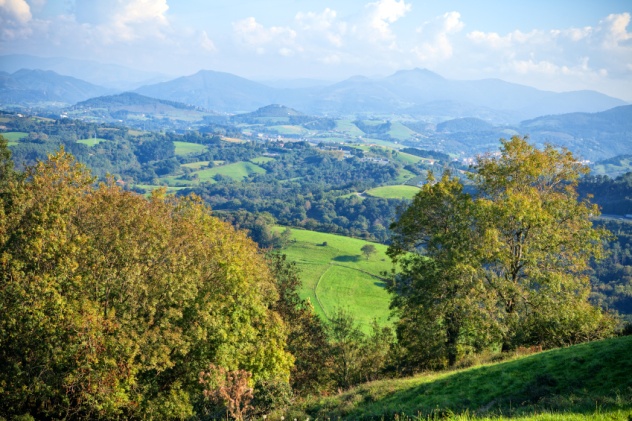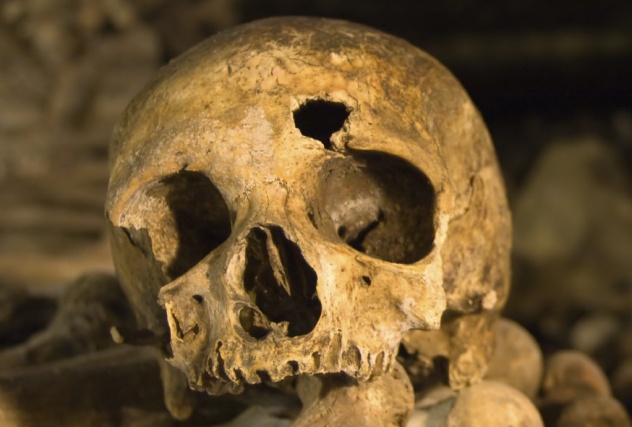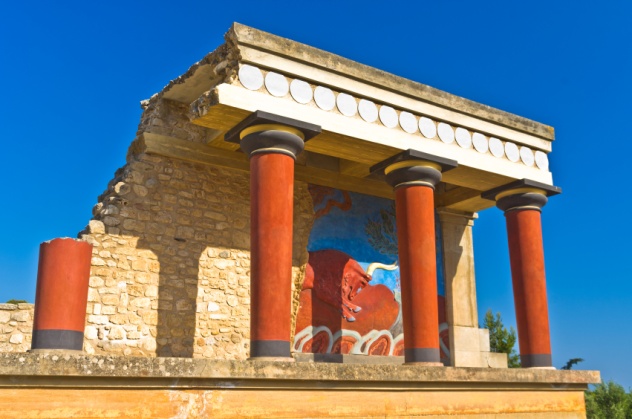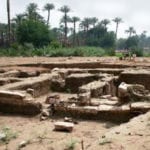 History
History  History
History  Technology
Technology Top 10 Everyday Tech Buzzwords That Hide a Darker Past
 Humans
Humans 10 Everyday Human Behaviors That Are Actually Survival Instincts
 Animals
Animals 10 Animals That Humiliated and Harmed Historical Leaders
 History
History 10 Most Influential Protests in Modern History
 Creepy
Creepy 10 More Representations of Death from Myth, Legend, and Folktale
 Technology
Technology 10 Scientific Breakthroughs of 2025 That’ll Change Everything
 Our World
Our World 10 Ways Icelandic Culture Makes Other Countries Look Boring
 Misconceptions
Misconceptions 10 Common Misconceptions About the Victorian Era
 Mysteries
Mysteries 10 Strange Unexplained Mysteries of 2025
 History
History 10 Things You Didn’t Know About the American National Anthem
 Technology
Technology Top 10 Everyday Tech Buzzwords That Hide a Darker Past
 Humans
Humans 10 Everyday Human Behaviors That Are Actually Survival Instincts
Who's Behind Listverse?

Jamie Frater
Head Editor
Jamie founded Listverse due to an insatiable desire to share fascinating, obscure, and bizarre facts. He has been a guest speaker on numerous national radio and television stations and is a five time published author.
More About Us Animals
Animals 10 Animals That Humiliated and Harmed Historical Leaders
 History
History 10 Most Influential Protests in Modern History
 Creepy
Creepy 10 More Representations of Death from Myth, Legend, and Folktale
 Technology
Technology 10 Scientific Breakthroughs of 2025 That’ll Change Everything
 Our World
Our World 10 Ways Icelandic Culture Makes Other Countries Look Boring
 Misconceptions
Misconceptions 10 Common Misconceptions About the Victorian Era
 Mysteries
Mysteries 10 Strange Unexplained Mysteries of 2025
10 Recent Discoveries Concerning Ancient Europe
Not very long ago, the common consensus was that “civilization” developed slowly in Europe. Outside of the Mediterranean civilizations of Greece and Italy, ancient Europe was a backwater full of barbaric tribesmen who mostly lived in hut-like dwellings. Most laymen and many historians would say that compared to Sumer, Babylon, China, Egypt, and the Indus River Valley, Europe was far behind the curve.
This attitude is undergoing a transformation. Thanks to recent archaeological discoveries, it’s becoming clearer and clearer that ancient Europe, especially prehistoric Europe, was far more developed than previously thought. This development wasn’t just in the Mediterranean basin, either. Archaeologists have not only unearthed evidence of professional armies, advanced technologies, and elaborate social structures in the mountains of Northern Europe and the Balkans, but they’ve even decoded some of the continent’s oldest mysteries.
10 The Origins Of The Celts
In 2006, Bertie Currie, the owner of McCuaig’s Bar in County Antrim, Northern Ireland, made a curious discovery while clearing land for a driveway. Underneath a large stone, Currie found several bones. Once the police concluded that McCuaig’s Bar wasn’t sitting on top of a crime scene, archeologists moved in. What they found was revolutionary—three skeletons that predate the arrival of the Celts in Ireland by 1,000 years or more.
Although recent radiocarbon dating put the origins of the skeletons at about 2000 BC, scientists at Oxford, the University of Wales, Queen’s University Belfast, and Trinity College Dublin found that DNA recovered from the ancient bones closely resembled that of modern-day individuals from Ireland, Scotland, and Wales. Such a find calls into question the presiding belief that Celts from mainland Europe migrated to the British Isles sometime between 1000 and 500 BC.
As a result, many theories have been put forward that rewrite common wisdom about the British Isles. Some concluded that the skeletons reveal that Irish, Scottish, and Welsh DNA originates from the Middle East and Eastern Europe, thereby arguing for multiple migrations that predated the Celtic movement northward from their homes in Germany, Austria, and Spain. Others, like Barry Cunliffe, argue that the skeletons show that Celtic civilization began in the British Isles and then spread to mainland Europe. Another group argues that the prehistoric Irish may have even predated the arrival of Indo-Europeans. Whatever the truth, it’s clear that what we know about prehistoric Ireland is about to change.
9 The Origins Of The Basque

The Basque people of Northeastern Spain and Southern France have always been a mystery. Unlike their neighbors, the Basque mountaineers do not speak a Romance language based on the Latin tongue of ancient Rome. Furthermore, the Basque language is a language isolate, meaning that it doesn’t have any recognizable links with the Indo-European languages of Europe.
In 2015, Mattias Jakobsson of Sweden’s Uppsala University put forth the notion that the Basque are the descendants of Iberian farmers who migrated north and mixed with an indigenous hunter-gatherer population. Basing his argument on Stone Age skeletons found in Northern Spain, Jakobsson believes that Iberians from Southwestern Spain began their move north between 3,500 and 5,500 years ago. After intermarrying with the local population, geographical and cultural isolation helped to preserve the unique Basque DNA. Importantly, although Jakobsson’s research undergirds the long-held belief that the Basque people are separate from modern Europeans, he nevertheless refutes the idea that the Basque are a continuation of a pure Neolithic civilization.
Other genetic researchers have gone further in refuting the notion of Basque uniqueness. Based on a survey of European genomes, some genetic scientists have concluded that the Basque are not unique and share much of their genetic material with other Europeans.
8 Bronze Age Warfare

For years, most historians have proclaimed that Stone Age warfare in Europe was predominately done by clans. The battles were small in scale and only included a handful of fighters facing each other. Large battles with massive casualties were uncommon in prehistoric Europe, especially in underdeveloped Northern Europe. A series of excavations conducted between 2009 and 2015 in Germany’s Tollense Valley has proven just the opposite.
Two huge armies battled one another on the banks of the Tollense River 3,200 years ago. The fighters were armed with spears, swords, war clubs, and arrows tipped with both bronze and flint. At the battle’s end, hundreds of fighters were dead. Many were professional warriors, and some were natives of Southern and Eastern Europe.
After an amateur archaeologist first discovered a punctured skull in 1996, professional archaeologists and scientists moved in to uncover more evidence. As it stands today, the battle, which occurred around 1250 BC, was fought between members of a widespread European warrior class. Many of the men wore gold rings, while many more took gold rings and other pieces of jewelry off slain corpses. More tantalizing, some have proposed that the battle was part of a larger war in Northern Europe between local tribesmen and southern invaders.
7 The Roots Of Europeans
In April 2016, a team of genetic scientists unveiled in the journal Nature that Ice Age Europe experienced several migrations near the end of the Neanderthal period. In particular, Iberian populations moved northward and westward, while peoples from today’s Greece and Turkey similarly moved north into the Balkans and the plains of Southeastern Europe. The study also concluded that all Europeans were at one time related to the inhabitants of ancient Belgium.
Specifically, the study argued that all Europeans come from a single founding population that existed during the Ice Age. The population spread throughout all of Europe approximately 33,000 years ago. Reexpansion occurred 19,000 years ago, but 5,000 years later, Europe experienced a dramatic population turnover stemming from the east. For the most part, the original population was located in northwestern Europe and spread from there.
According to Professor David Reich of the Harvard Medical School and Svante Paabo of Leipzig’s Max Planck Institute for Evolutionary Anthropology, the prevailing populations of Ice Age Europe can be broken down into four clusters—the Aurignacians (the founding society in Belgium that had nobles and kings), the Gravettians (the descendants of the Aurignacians), the Magdalenians (a culture from modern-day Spain), and the Villabruna people (an Italian people who carried traces of European and Middle Eastern DNA).
6 ‘Mega Stonehenge’
People have been fascinated by England’s Stonehenge for generations. A prehistoric circle of standing stones located near Amesbury, Wiltshire, Stonehenge may have been everything from a solar temple to a burial ground, or both. Using radar, scientists discovered in 2014 that the Stonehenge area was much larger than its ruins today. Specifically, a larger structure 3.2 kilometers (2 mi) from Stonehenge once included multiple burial mounds, chapels, shrines, trenches, and an even larger monument made up of 50 stones and an enclosure 330 meters (1,082 ft) long.
Called “superhenge” or “mega Stonehenge” by investigators connected to the Stonehenge Hidden Landscapes project, the site near Durrington Walls has been connected to Neolithic rituals. The buried stones are believed to be local sarsen blocks, while the entire complex may have surrounded springs associated with the River Avon. All told, the recently discovered “superhenge” dwarfs Stonehenge and may be the largest Neolithic site ever discovered in Europe. Its connection to nearby Stonehenge has yet to be discovered.
5 Prehistoric Bulgaria’s Giant Cult Complex
Reported in 2015, archaeologists associated with the New Bulgarian University in Sofia uncovered a massive Stone Age structure in Northeastern Bulgaria. Located on the Big Island in Durankulak Lake, the stone city, which may be the first in European history, existed sometime between 5500 and 5400 BC. The inhabitants probably belonged to the Hamangia-Durankulak Culture of Middle Neolithic Europe, a prehistoric culture located in the Balkans and around the Black Sea.
In the heart of the city was a cult complex that included some 1,400 graves and religious artifacts. Archaeologists have further discovered that the complex was two stories tall and covered over 200 square meters (2,220 ft2). Dubbed the “Dobrudzha Troy,” the stone city probably collapsed due to an earthquake. Excavations at the site, which began back in the 1970s, have also uncovered precious jewels, copper, and gold. It’s believed that the inhabitants of Dobrudzha Troy were experts at forging, and it’s likely that they traded these items all across the Mediterranean. If true, the largest prehistoric structure in Europe may have also been the birthplace of smelting.
4 Bronze Age Britain’s Pompeii
While the ancient British didn’t invent wheeled transport, they might have built the ancient world’s largest wheels during the Bronze Age. In early 2016, a team of archaeologists working in the fens of Cambridgeshire unearthed a large wheel that may have been used in a two-wheeled cart pulled by an ox or horse. At 3.5 centimeters (1.4 in) thick and 1 meter (3 ft) in diameter, the wheel has been dated to around 1000 BC.
Besides the wheel, which was made entirely of oak planks, excavators at the site have found the partially buried skull of a woman, roundhouses, animal bones, sedge thatch, roof and floor timbers, cooking pits, tools, and weapons. Sadly, 3,000 years ago, the entire settlement was destroyed by a fire.
Despite this, much of the settlement was preserved. Thanks to teeth and bones, scientists have found that the inhabitants ate lamb, pork, beef, venison, and varieties of grain. They also traveled by carts and boats, with the latter being the predominate means of transport. Because of all of these findings, the site has been dubbed the “Fenland Pompeii” because it offers modern archaeologists the chance to investigate the day-to-day life of Bronze Age Britain up close.
3 The Lasting Power Of Knossos

Since being excavated by the British archaeologist Sir Arthur Evans in the early 20th century, the ancient city of Knossos has been examined by generations of archaeologists and historians. Located on the Greek island of Crete, Knossos was the principal city of the Minoans, a pre-Mycenaean civilization that interacted heavily with the larger Mediterranean world. At its peak, Knossos was the preeminent power in mainland Greece. According to one popular reading, the myth of the Minotaur and the Labyrinth is a parable about the Mycenaean Greek struggle to free itself from having to pay yearly tributes to the powerful court at Knossos.
Until recently, it was believed that Knossos and the entire Minoan civilization collapsed around 1200 BC. The collapse was brought forth by both the eruption of the Santorini volcano and the so-called Late Bronze Age Collapse, which saw Indo-European pirates from the Mediterranean and Aegean seas invading and occupying much of the Near East. However, in early 2016, field researchers with the Knossos Urban Landscape Project unveiled that recent digs at Knossos proved that the city rebuilt itself into a trading power in the 11th century BC. Rather than collapse into political and social anarchy, Knossos expanded in size as imports from mainland Greece, the Western Mediterranean, Egypt, and the Near East kept the economy strong.
2 Ancient Terrorism
Like the discovery in Tollense Valley, a 2006 discovery in Schoneck-Kilianstadten, Germany, may change what we know about ancient warfare in northern Europe. By 2015, archaeologists had identified the remains of farmers belonging to the Linear Pottery culture. The 7,000-year-old skeletons, which include 26 adults and children, show signs of close quarters combat, and many have caved in or punctured skulls. As for weapons, archaeologists have mostly found arrowheads made of animal bone. Frighteningly, the archaeologists have also discovered evidence of torture, with the skeletons displaying intentionally broken bones and other signs of posthumous mutilation.
Sometimes called Europe’s “first farmers,” the Linear Pottery culture controlled much of central Europe between 5600 and 4900 BC. Initially, the Linear Pottery culture was believed to be mostly peaceful, with farming being the central occupation. However, in the late 1980s, archaeologists discovered a mass grave in Talheim, Germany, that showed signs of wanton murder. Then, another mass grave near Asparn/Schletz, Austria, further highlighted the fact that the Linear Pottery culture engaged in conquest and committed massacres against civilian populations. A grave near Herxheim, Germany, also indicated that the Linear Pottery culture performed acts of cannibalism during certain rituals.
As for the find at Schoneck-Kilianstadten, archaeologists believe that the farmers were killed in order to terrify other villagers in the area. Whether this was simple terrorism or part of a larger war in northern Europe is not yet known.
1 The Ness Of Brodgar
In 2012, archaeologists working in Scotland’s remote Orkney Islands revealed to the world their findings concerning the remains of a settlement first occupied around 3200 BC. The settlement, known as the Ness of Brodgar, contains some of the oldest (if not the oldest) painted walls in Europe, while the site’s earth- and stonework predates Stonehenge by thousands of years. Furthermore, the Ness of Brodgar contains a wealth of artifacts relating to the Neolithic religion of the British Isles, which may hold the key to understanding Stonehenge and the various stone circles throughout Great Britain.
According to an article written by Roff Smith for National Geographic, the Ness of Brodgar was in use for over 1,000 years. The site served as the center of the area’s religious practices, thus giving it a ceremonial function. Although important, the Ness of Brodgar was not entirely unique. Indeed, Stone Age Orkney was dotted with megaliths, stone tombs, and villages. More tantalizing still, the Ness of Brodgar, which predates the building of the Egyptian pyramids, may hold clues about extensive trade networks between the Orkneys, mainland Scotland, and other parts of Northern Europe.
Benjamin Welton is a freelance writer based in Boston. His work has appeared in The Weekly Standard, The Atlantic, Listverse, Metal Injection, and others. He currently blogs at literarytrebuchet.blogspot.com.








